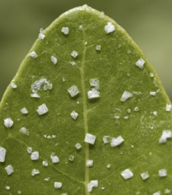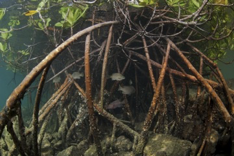July 21, 2020
Ras Al Khaimah's Mangrove Wetlands: An Ecological Asset Worth Preserving
The mangrove wetlands in Ras Al Khaimah are one of only a few varieties of flora and fauna that can eke out a life in the hot, dry climate of the United Arab Emirates. These small forests are unique in their ability to survive the harsh environment and their vibrancy in an otherwise dull landscape of concrete buildings and sandy areas. In this blog, I explore the unique characteristics and ecosystem services of Ras Al Khaimah's mangrove wetlands, how residents perceive the need for the mangrove's protection against the backdrop of economic and urban development, and introduce several policy alternatives we can undertake to safeguard these valuable natural resources.
Mangrove Wetlands: A Unique Ecosystem
Mangroves are salt-tolerant trees or bushes that survive in intertidal zones where water levels tend to fluctuate. In Ras Al Khaimah, the largest concentration of mangroves is located in Khor Ras Al Khaimah, where the Arabian Gulf's dominant species Avicennia marina (the grey mangrove) presides. Over time, these trees have evolved from inland species and adapted to a habitat of high salinity and soft, oxygen-poor soil by either blocking salt from entering the plant tissue or excreting the compound through their leaves. Their unique roots, known as pneumatophores, grow vertically and emerge above the soil's surface to take in oxygen during low tides. In adapting to their highly dynamic environment, mangrove seeds germinate and grow on their parents before dropping off into the seawater, where they float for days or weeks before settling down to the sea bottom. This process facilitates the spread of mangroves away from their parents, thus avoiding crowding in a particular location.
Mangroves provide valuable ecosystem services, benefiting their ecosystem at the social, economic, and environmental levels. Mangrove trees' heavily developed maze of roots provides fish roe and juveniles safe refuge from predators, helping maintain fish populations, including commercially valuable stocks. With their thick canopy, mangrove trees also provide ideal nesting and roosting ground for many bird species, including migratory birds looking for food and warmth in the winter. Furthermore, mangrove wetlands act as a filter by holding back silt sediment and pollutants and passing on clear and clean water to coral habitats. Thereby, their roots stabilize the shoreline against erosion. Due to their wide coverage, mangrove wetlands in urban areas, such as those in Ras Al Khaimah, help moderate the region's microclimate and reduce the likelihood of heatwaves. The mangroves in Khor Ras Al Khaimah also likely contribute significantly to improving air quality, sequestering carbon dioxide, and mitigating the impact of sand storms because of their dense canopy and influence over airflow patterns. Finally, these forests serve as a sanctuary to residents looking for relief from the stress of busy schedules, routine daily activities, and heavy traffic. The corniche area bordering the mangrove wetlands in RAK also supports several recreational and cultural activities and businesses, making it an important public gathering space.
Assessing Public Attitudes Towards Mangroves in Ras Al Khaimah
For my 2020 policy paper, Assessing Policy Alternatives and Public Support for Protecting the Ras Al Khaimah Mangrove, I carried out a study to assess the public's attitude towards the mangrove wetlands in Ras Al Khaimah. The attitudes of Ras Al Khaimah residents can be grouped into three categories:
- Biocentric: favors protection of the environment over development
- Anthropocentric: supports economic development even at the expense of the environment
- Ecocentric: believes in balancing environmental protection measures and economic development goals
The study, which considers multiple factors, including age, gender, education, income, and duration of residency in Ras Al Khaimah, illustrates that most people favor protecting the mangrove wetlands. It further reveals that people's environmental attitudes are significantly shaped by how long they have resided in Ras Al Khaimah, their age, and their education level. The longer a person had lived in Ras Al Khaimah, the more likely they are to favor environmental protection over economic development. Similarly, the older a person is and the higher their degree attainment, the more likely they are to be Biocentric. Interestingly, environmental attitude is independent of gender and income. The corresponding data can be seen in more detail in my policy paper.
Policy Recommendations
It is evident that not only do Ras Al Khaimah's mangrove wetlands contribute essential ecosystem services, but residents are overwhelmingly in favor of preserving them. Considering the lack of detailed information on the mangroves, commissioning a thorough assessment of the wetlands is crucial to determining environmental quality, causes of degradation, and remedial measures that should be undertaken. It is also necessary to support research that assesses the ecosystem services of the mangrove wetlands and develop low-cost, highly effective monitoring programs of mangrove areas.
I further recommend several policies to safeguard the mangroves, including exploring options that incorporate their protection into urban development plans. Moreover, development and environmental protection goals can be merged through eco-tourism, such as establishing national parks, which can further raise awareness and appreciation of their ecological benefits. It is also essential to introduce coastal development guidelines that limit landfilling and dredging while preventing waste dumping and the release of untreated wastewater in the mangrove wetlands. Instead, treated wastewater can be diverted to mangrove areas to moderate high seawater salinity in the Khor area. Finally, it would be prudent to designate the Avicennia marina mangrove as a protected species under Ras Al Khaimah government regulations.
Ras Al Khaimah's mangrove wetlands are under threat from encroaching development, which directly claims land from the mangroves and releases waste into their waterways, thereby threatening the environmental sustainability and long-term economic and societal development of the emirate. We must act now to preserve the emirate's mangroves and their respective ecosystems.
To learn more about the importance of preserving the Ras Al Khaimah's mangrove wetlands, resident's perceptions on economic development and environmental protection, and the associated policies and recommendations, refer to Hamed Assaf's policy paper "Assessing Policy Alternatives and Public Support for Protecting the Ras Al Khaimah Mangrove."
Dr. Hamed Assaf is the Interim Dean of the School of Engineering at the American University of Ras Al Khaimah. He received his Ph.D. in Civil Engineering (Water Resources) from the University of British Columbia, Canada. His work focuses on climate change, its potential impact in the Arab region, and adaptation options.



